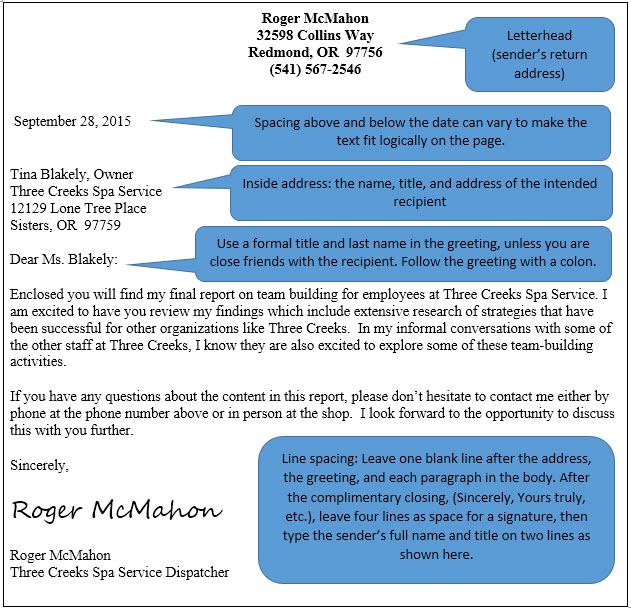1.5 Letters
Letters are usually brief messages (one to two pages) sent to recipients that are often outside the organization. They are often printed on letterhead paper and represent the business or organization. While e-mail and text messages may be used more frequently today, the effective business letter remains a common form of written communication. It can serve to introduce you to a potential employer, announce a product or service, or even serve to communicate feelings and emotions. We’ll examine the basic outline of a letter and then focus on specific products or, if for a college course, writing assignments.
All letters have expectations in terms of language and format. The audience or readers may have their own ideas of what constitutes a specific type of letter, and your organization may have its own format and requirements. This chapter outlines common elements across letters, and attention should be directed to the expectations associated with your particular writing assignment. There are many types of letters, and many adaptations in terms of form and content, but in this chapter, we discuss the fifteen elements of a traditional block-style letter. Letters may serve to introduce your skills and qualifications to prospective employers, deliver important or specific information, or serve as documentation of an event or decision. Figure 3 demonstrates a cover letter that might introduce a technical report to its recipient.
Figure 3. Sample cover letter (click image for an accessible PDF)
Strategies for effective letters
Remember that a letter has five main areas:
- The heading, which names the recipient, often including address and date
- The introduction, which establishes the purpose
- The body, which articulates the message
- The conclusion, which restates the main point and may include a call to action
- The signature line, which sometimes includes the contact information
Always remember that letters represent you and your company in your absence. In order to communicate effectively and project a positive image, remember that
- your language should be clear, concise, specific, and respectful;
- each word should contribute to your purpose;
- each paragraph should focus on one idea;
- the parts of the letter should form a complete message;
- the letter should be free of errors.
Letters with specific purposes
Cover letters. When you send a report or some other document to your supervisor, send it with a cover letter that briefly explains the purpose of the report and your major findings. Although your supervisor may have authorized the project and received periodic updates from you, s/he probably has many other employees and projects going and would benefit from a reminder about your work.
Letters of inquiry. You may want to request information about a company or organization such as whether they anticipate job openings in the near future or whether they fund grant proposals from non-profit groups. In this case, you would send a letter of inquiry, asking for additional information. As with most business letters, keep your request brief, introducing yourself in the opening paragraph and then clearly stating your purpose and/or request in the second paragraph. If you need very specific information, consider placing your requests in list form for clarity. Conclude in a friendly way that shows appreciation for the help you will receive.
Job application letters. Whether responding to job announcements online or on paper, you are likely to write a job application letter introducing yourself and your skills to a potential employer. This letter often sets a first impression of you, so demonstrate professionalism in your format, language use, and proofreading of your work. Depending on the type of job you are seeking, application letters will vary in length and content. In business, letters are typically no more than one page and simply highlight skills and qualifications that appear in an accompanying resume. In education, letters are typically more fully developed and contain a more detailed discussion of the applicant’s experience and how that experience can benefit the institution. These letters provide information that is not necessarily evident in an enclosed resume or curriculum vitae.
Follow-up letters. Any time you have made a request of someone, write a follow-up letter expressing your appreciation for the time your letter-recipient has taken to respond to your needs or consider your job application. If you have had a job interview, the follow-up letter thanking the interviewer for his/her time is especially important for demonstrating your professionalism and attention to detail.
Letters within the professional context may take on many other purposes, but these four types of letters are some of the most common that you will encounter. For additional examples of professional letters, take a look at the sample letters provided by David McMurrey in his online textbook on technical writing: https://www.prismnet.com/~hcexres/textbook/models.html
Chapter Attribution Information
This chapter was derived by Annemarie Hamlin, Chris Rubio, and Michele DeSilva, Central Oregon Community College, from the following sources:
- Online Technical Writing by David McMurrey – CC: BY 4.0
- Professional Writing by Saylor Academy – CC: BY 3.0


